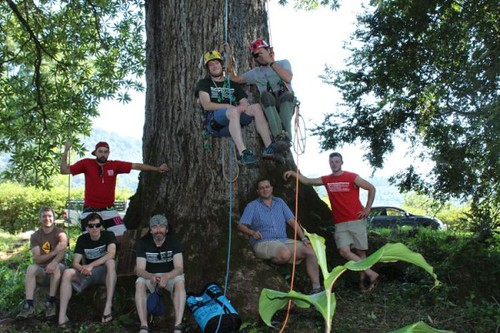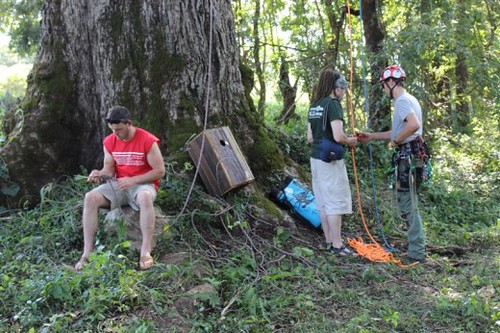 From left: Ryan Cafferky, Chris Monks, Rhys Spooner, Martin Spooner, Wynand Espach and Jack Keyzar. Hanging from the tree are, David Wiles, left and Drew Bristow, right. Image by Letaba Herald
From left: Ryan Cafferky, Chris Monks, Rhys Spooner, Martin Spooner, Wynand Espach and Jack Keyzar. Hanging from the tree are, David Wiles, left and Drew Bristow, right. Image by Letaba Herald
Amorentia Estate has been testing different kinds of artificial parrot breeding boxes for the last few years to see if they can get the highly endangered Cape Parrot to breed in the Politsi Valley near Tzaneen in Limpopo.
They have had the parrots investigate the nest boxes, but have been unsuccessful due to two factors: they could not get the boxes installed high enough, and bees kept invading the boxes within days of installation, Letaba Herald reported.
Through many hours of research between Amorentia Estate and Explore Trees, they came across research that was done by Caroline Efstathion from the University of Florida, and through her, they were put in contact with funders of such environmental projects.
Their project was approved and was funded by various institutions, such as the University of Florida, the Loro Parque Foundation, the Parrot Fund and Susan Hilliard. The funding covered the manufacture of 20 parrot nest boxes and 40 bee boxes as well as all the travel, accommodation and meals for some of the experts who will be joining them for 14 days and some other smaller expenses like bee keeping equipment.
Earlier this month, two researchers from the University of Florida, four tree climbers from the UK, two tree climbers from New Zealand, one tree climber from Scandinavia and a film crew from People’s Weather arrived at Amorentia Estate and started the project.
 Next to the tree is one of the parrot breeding boxes. From left: Jack Keyzar, Martin Spooner and Drew Bristow. Image by Letaba Herald
Next to the tree is one of the parrot breeding boxes. From left: Jack Keyzar, Martin Spooner and Drew Bristow. Image by Letaba Herald
There are 20 sites that have been identified on and around the estate. Each site will have one parrot nest box installed as high as possible in the canopy of the tree, and will be accompanied by two bee boxes in the same tree or nearby, but at two lower levels.
The team from Florida has been very successful in using what they call a push-pull method. Basically, the parrot boxes are treated with a chemical that repel the bees and the bee boxes are treated with a pheromone that attracts bees.
The bees then stay away from the parrot boxes, leaving it available for the parrots to breed in. Some of the locals as well as Amorentia employees will be trained by the researchers in bee keeping, as this is one of their specialties. The bees will be removed from these trap boxes and moved into hives in the orchards for pollination.
All honey and wax will be taken out of the boxes and taken to a local farm school. At the farm school, one of the classrooms is currently being converted into a small factory.
The school will employ a local person who will lead the project at the school and the children will be involved in the afternoons. All honey will be bottled, and wax will be used to make candles.
“If all goes according to plan we will therefore help the parrots, the bees, the farmers and the children. The long-term goal for the school would be to build a hostel for the children,” said Wynand Espach from Amorentia.